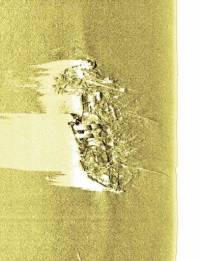Wessex Archaeology has just processed and interpreted sidescan and multibeam data from the wreck of the troopship Mendi, which sank with the loss of 649 lives after a collision off the Isle of Wight on 21 February 1917. The project was jointly funded by the South African Heritage Resources Agency (SAHRA) and English Heritage. Geophysical Survey of the Mendi During the summer of 2007 a Regional Environmental Characterisation (REC) survey was conducted along the south coast of the United Kingdom as part of the Department of the Environment, Food and Rural Affairs' (DEFRA) Marine Environment Protection Fund (MEPF) programme of regional seabed mapping. One of the planned survey lines was to pass within a mile or two of the Mendi, and at the request of Wessex Archaeology and English Heritage the REC Steering Group agreed to an adjustment of the line to allow the collection of data over the site of the wreck. What the Data Shows The geophysical data shows the wreck oriented approximately east to west - with the bow in the west and the stern in the east. The hull appears fairly coherent, but with a chaotic internal structure and some outlying deris.
Most of the collapsed wreckage from the superstructure seems to be concentrated within the hull. This confirms diver descriptions which indicate that with the exception of the bow and stern, the wreck has collapsed in many areas. Within the general collapse, the bow and stern remain relatively intact, as does the amidships section where the boilers and engine are clearly visible in the data. The bow appears to have broken away from the rest of the wreck and a large amount of scattered debris is present in this area. This may be the mark of the fatal damage suffered when the Mendi was rammed by the Darro. The break is in the area where survivors' accounts describe the bow of the Darro cutting deeply into the Mendi's hull - to within a couple of feet of her midline. What the geophysical data also appears to show is that when compared to diver reports about the condition of the wreck, the bow and stern have seen a marked deterioration in last 3-5 years, and this may be indicative of a more general, rapid degradation of the wreck as a whole. Previous Work The geophysical assessment builds on previous work conducted by Wessex Archaeology in 2007. To coincide with the 90th anniversary year of the sinking of the Mendi, funding was provided by English Heritage to undertake a desk-based appraisal of the wreck and its story. This appraisal drew together a huge amount of information about the events surrounding the loss of the ship. It gathered, for the first time, available information about the wreck itself, and allowed us to start creating a picture of the wreck site - its layout, condition and state of preservation. Perhaps most importantly, the desk-based work showed that the wreck of the Mendi is an important physical focus for investigating a little known and largely forgotten aspect of World War I history - the story of the British and Foreign Labour Corps. Of the men who died when the Mendi sank, most were non-combatant black South African labourers, en route to France to support British operations on the Western Front. Future Surveys The recent geophysical assessment has identified a range of target areas for investigation during a Remotely Operated Vehicle (ROV) survey that Wessex Archaeology hopes to carry out on the wreck in the near future. We would like to gather better evidence of the condition and relative stability of the wreck, the possible impacts of human intervention on the site since its discovery, and the information relevant to its future survival. We're also interested in a non-intrusive investigation of the artefacts that survive on the wreck which speak for the presence of more than 800 South African servicemen on the Mendi when she sank.

